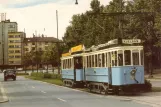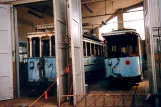Oslo railcar 521
Exhibited in a museumDescription
The cart was taken over by Kristinia Sporveisselskab in 1905 and was rebuilt and extended in 1922. The wagon was in Cologne during World War 2 and was bombed, but later rebuilt there.
Was in Germany from 1944 to 1946.
The history of the tram
Kristiania Kommunale Sporveie (KKS)
Closed
1921: Delivered as Oslo railcar 521, manufacturer KSS verksted/Siemens-Schuckertwerke (SSW), type mv, series 121-137, width 2.00 m, length 11.20 m, weight 16.0 t, manufactured 1921-1923, with 24 seats and 44 standing places, power output 102 kW, max speed 40 km/t.
Sporveien
Operational
1922: Rebuilt to Oslo railcar 121 (ex Oslo railcar 521), manufacturer HaWa, Siemens, series 25-34, width 2.00 m, length 10.00 m, weight 12.5 t, manufactured 1921-1922, with 20 seats and 30 standing places, 2 axles, 2 engines, power output 33 kW.
Kölner Verkehrs-Betriebe (KVB)
Operational
1944: Taken over by the company as Cologne railcar 521 (ex Oslo railcar 521), manufacturer KSS verksted/Siemens-Schuckertwerke (SSW), type mv, series 121-137, width 2.00 m, length 11.20 m, weight 16.0 t, manufactured 1921-1923, with 24 seats and 44 standing places, power output 102 kW, max speed 40 km/t.
Sporveien
Operational
1946: Taken over by the company as Oslo railcar 121 (ex Oslo railcar 521), manufacturer HaWa, Siemens, series 25-34, width 2.00 m, length 10.00 m, weight 12.5 t, manufactured 1921-1922, with 20 seats and 30 standing places, 2 axles, 2 engines, power output 33 kW.
 Postcard: Oslo railcar 121 on Kirkeveien (1950-1960)By Henrik Boye, Lokaltrafikkhistorisk Forening (LTF).
Postcard: Oslo railcar 121 on Kirkeveien (1950-1960)By Henrik Boye, Lokaltrafikkhistorisk Forening (LTF).1950 - 1960.
Oslo Transport Museum Vognhall 5
Open regularly
1967: Arrived at a museum as Oslo railcar 121 (ex Oslo railcar 521), manufacturer Busch/KSS, width 2.00 m, length 11.90 m, weight 15.0 t, manufactured 1922, with 24 seats and 44 standing places, 2 engines, power output 51 kW.
